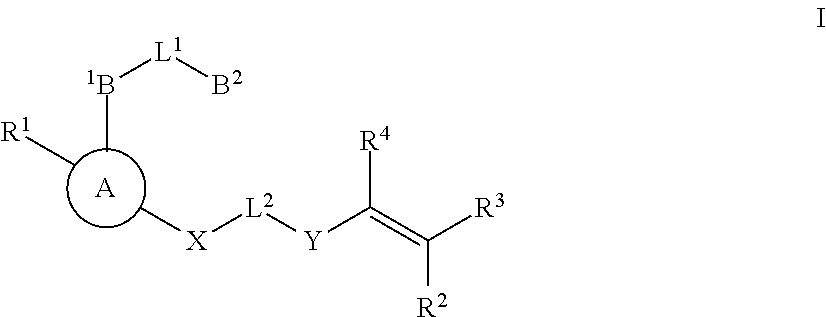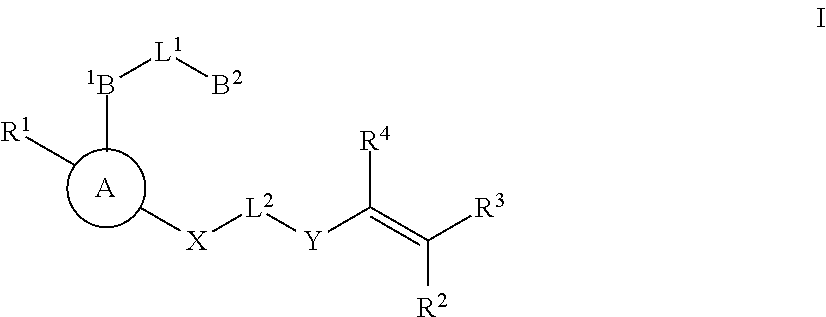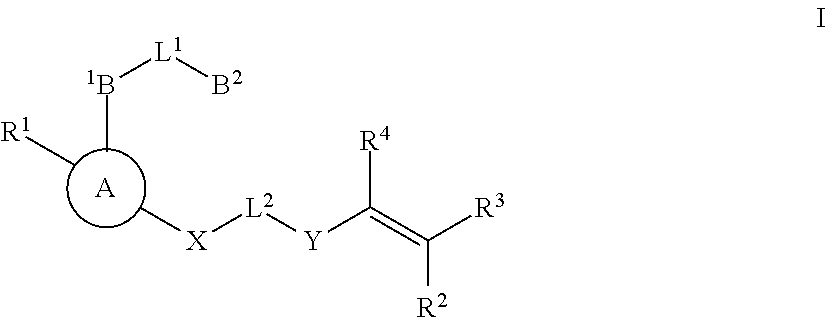Substituted nicotinamide inhibitors of BTK and their preparation and use in the treatment of cancer, inflammation and autoimmune disease
a technology of nicotinamide inhibitors and btk, which is applied in the field of substituted nicotinamide inhibitors of btk and their preparation and use in the treatment of cancer, inflammation and autoimmune diseases, can solve the problems of significant relapse of patients, and significant reduction of survival rates of patients diagnosed with abc-dlbcl compared with individuals with other types of dlcbl, so as to redu
- Summary
- Abstract
- Description
- Claims
- Application Information
AI Technical Summary
Benefits of technology
Problems solved by technology
Method used
Image
Examples
example 1
6-(3-acrylamidophenyl)-2-(4-phenoxyphenyl)nicotinamide
[0189]
[0190]To a solution of 6-(3-aminophenyl)-2-(4-phenoxyphenyl)nicotinamide 7 (38 mg, 0.1 mmol) in DCM (5 mL) was added TEA (0.05 mL, 0.4 mmol) and acryloyl chloride 8 (9 mg, 0.1 mmol) at 0° C. The mixture was stirred at 0° C. for 10 minutes. The solvent was removed and the residue was purified by Prep-TLC eluting with 25:1 DCM / MeOH to afford the title compound (30 mg, 71%) as white solid. 1H NMR (400 MHz, DMSO) δ 10.36 (s, 1H), 8.43 (s, 1H), 7.72-7.97 (m, 7H), 7.49 (s, 1H), 7.33-7.52 (m, 3H), 7.24 (t, J=6.9 Hz, 1H), 6.9-7.13 (m, 4H), 6.45 (dd, J=16.9, 10.0 Hz, 1H), 6.30 (d, J=16.9 Hz, 1H), 5.79 (d, J=10.5 Hz, 1H), MS (ESI, method A): m / z=436.0 [M+H]+, tR=1.553 min., HPLC: 97.5% (214 nm), 98.0% (254 nm).
[0191]
2,6-dichloronicotinamide (2)
[0192]To 2,6-dichloronicotinonitrile 1 (1.73 g, 10 mmol) was added conc H2SO4 (10 mL) and water (2 mL). The mixture was heated to 90° C. and stirred for 1 h. After cooling to room temperature, ...
example 3
6-(1-acryloylpiperidin-4-yl)-2-(4-phenoxyphenyl)nicotinamide
[0197]
[0198]To a solution of 2-(4-phenoxyphenyl)-6-(piperidin-4-yl)nicotinamide 8 (26 mg, 0.07 mmol) in DCM (5 mL) was added TEA (0.05 mL, 0.4 mmol) and acryloyl chloride 9 (7 mg, 0.07 mmol) at 0° C. The mixture was stirred at 0° C. for 10 minutes. The solvent was removed and the residue was purified by Prep-TLC eluting with 25:1 DCM / MeOH to afford the title compound (13 mg, 44%) as white solid. 1H NMR (400 MHz, CDCl3) δ 7.90 (d, J=8.0 Hz, 1H), 7.71-7.62 (m, 2H), 7.42-7.31 (m, 2H), 7.21-7.11 (m, 2H), 7.10-7.01 (m, 4H), 6.60 (dd, J=16.8, 10.5 Hz, 1H), 6.26 (dd, J=16.8, 2.0 Hz, 1H), 5.84 (s, 1H), 5.68 (dd, J=10.5, 2.0 Hz, 1H), 5.54 (s, 1H), 4.79 (d, J=13.3 Hz, 1H), 4.13 (d, J=12.8 Hz, 1H), 3.17 (t, J=12.3 Hz, 1H), 3.39 (t, J=11.7 Hz, 1H), 2.76 (t, J=11.7 Hz, 1H), 2.03 (br, 2H), 1.80 (ddd, J=25.5, 12.5, 4.2 Hz, 2H). MS (ESI, method A): m / z=428.0 [M+H]+, tR=1.480 min. HPLC: 96.7% (214 nm), 99.3% (254 nm).
[0199]
Tert-butyl 4-(6-c...
example 5
6-(4-acryloylpiperazin-1-yl)-2-(4-phenoxyphenyl)nicotinamide
[0203]
[0204]To a solution of 2-(4-phenoxyphenyl)-6-(piperazin-1-yl)nicotinamide 6 (59 mg, 0.16 mmol) in DCM (5 mL) was added TEA (0.05 mL, 0.4 mmol) and acryloyl chloride 7 (14 mg, 0.16 mmol) at 0° C. The mixture was stirred at 0° C. for 10 minutes. The solvent was removed and the residue was purified by Prep-TLC eluting with 25:1 DCM / MeOH to afford the title compound (27 mg, 40%) as light yellow solid. 1H NMR (400 MHz, CDCl3) δ 8.04 (d, J=8.7 Hz, 1H), 7.64 (d, J=8.2 Hz, 2H), 7.40 (t, J=7.6 Hz, 2H), 7.18 (t, J=7.3 Hz, 1H), 7.08 (dd, J=12.0, 8.4 Hz, 4H), 6.66 (d, J=8.5 Hz, 1H), 6.64-6.56 (m, 1H), 6.37 (d, J=16.7 Hz, 1H), 5.77 (d, J=10.6 Hz, 1H), 5.57 (s, 1H), 5.33 (s, 1H), 3.81 (s, 4H), 3.73 (s, 4H). MS (ESI, method A): m / z=429.2 [M+H]+, tR=1.454 min., HPLC: 97.5% (214 nm), 98.0% (254 nm).
[0205]
6-chloro-2-(4-phenoxyphenyl)nicotinamide (1)
[0206]6-chloro-2-(4-phenoxyphenyl)nicotinamide 1 was synthesized by using the same proce...
PUM
 Login to View More
Login to View More Abstract
Description
Claims
Application Information
 Login to View More
Login to View More - R&D
- Intellectual Property
- Life Sciences
- Materials
- Tech Scout
- Unparalleled Data Quality
- Higher Quality Content
- 60% Fewer Hallucinations
Browse by: Latest US Patents, China's latest patents, Technical Efficacy Thesaurus, Application Domain, Technology Topic, Popular Technical Reports.
© 2025 PatSnap. All rights reserved.Legal|Privacy policy|Modern Slavery Act Transparency Statement|Sitemap|About US| Contact US: help@patsnap.com



